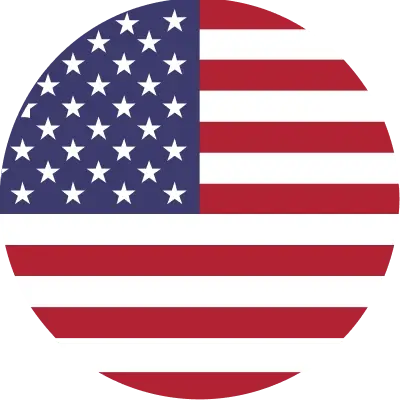Summary:
Customer service expectations are the baseline standards customers assume every company will deliver, quick replies, accurate information, respectful treatment, and straightforward ways to resolve issues across channels. These expectations aren’t fixed. They rise every time customers experience a faster, easier, or more personalized service elsewhere. In practice, this means that what was considered “good service” last year, like a 24-hour email reply, may already feel slow today.
The 10 most common expectations today:
- A fast first reply and visible progress on issues
- Consistent information no matter the channel
- Support that recognizes past history and context
- Proactive updates before customers have to ask
- Self-service options that actually resolve problems
- A simple path to reach a person when needed
- Clear rules around privacy and data use
- Honest timelines and transparent communication
- Mobile-friendly, accessible support experiences
- Proper closure and follow-through after resolution
Now, let’s break this down
What are customer expectations?
Customer service expectations are the set of standards, both spoken and unspoken, that customers carry into every interaction with a company. At their core, they cover speed of response, accuracy of information, empathy in communication, and the ability to resolve issues with minimal effort.
But they also extend further: customers increasingly expect consistency across multiple channels, transparency about timelines or limitations, and proactive updates before they even have to ask.
Unlike formal service-level agreements (SLAs), customer expectations are shaped by personal experiences, peer recommendations, and comparisons with the “best” service encountered in any industry. A smooth order return from an e-commerce platform can raise expectations for a bank; a fast chat reply from a telecom provider can reset what a healthcare patient demands from their hospital. These rising standards become the new baseline across sectors, regardless of whether a company has promised them or not.
In practice, this means customer service expectations are dynamic benchmarks. They evolve quickly as technology changes and as businesses introduce faster, more personalized, and more convenient ways to serve.
Why understanding customer service expectations matters
Meeting customer service expectations is not a “soft” metric, it directly shapes revenue, loyalty, and long-term brand strength. When expectations are met, customers feel confident returning, recommending your business, and even paying a premium for the reliability you provide. When they are missed, the opposite happens: customers switch providers quickly, and the cost of replacing them is far higher than the cost of serving them well.
Research consistently shows the stakes.
For example, PwC found that 59% of customers will walk away after several bad experiences, even if they like a brand’s products. Other studies highlight the same pattern: loyalty erodes faster when service feels slow, inconsistent, or dismissive, regardless of product quality.
Understanding expectations also gives companies an advantage in highly competitive markets. With alternatives only a click away, customers rarely tolerate repeated friction. A fast, transparent, and empathetic support experience can be the difference between retaining a lifetime customer and losing them after a single poor interaction.
In short: customer expectations aren’t just benchmarks for your support team. They’re signals of how easy, or how frustrating, it is to do business with you. Companies that listen closely, adapt quickly, and align service with these expectations consistently outperform those that treat support as an afterthought.
Types of customer service expectations
Not all customer expectations are the same. Some are assumed, some are shaped by digital habits, and others shift as markets evolve. The main types are:
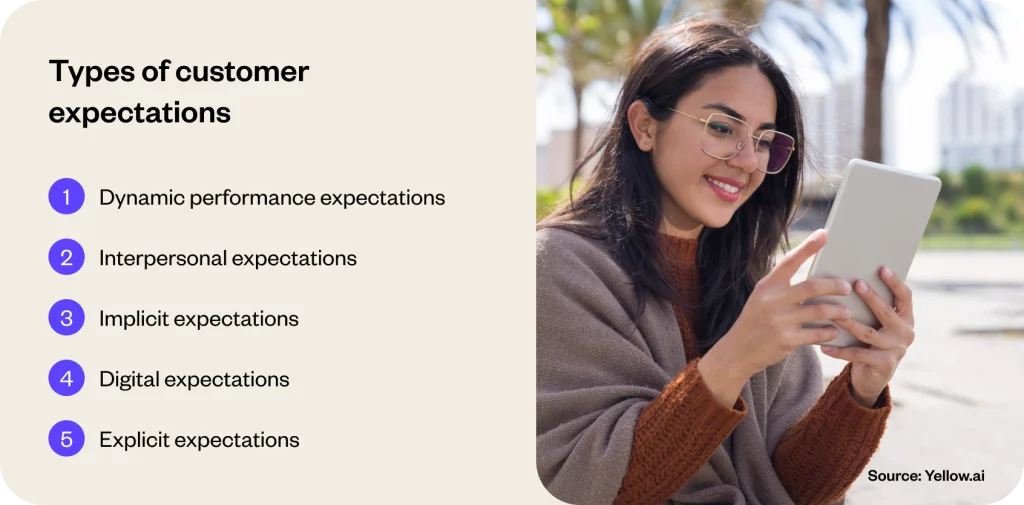
- Dynamic performance expectations
Customers expect products and services to improve over time. What felt acceptable last year, like a 24-hour response, may now feel slow. Keeping pace with competitors’ upgrades sets the new baseline. - Interpersonal expectations
These cover the quality of human interaction: empathy, respect, and ownership during conversations. Customers notice tone and clarity as much as the final resolution. - Implicit expectations
Assumptions customers carry without stating them. Often shaped by reviews, peer recommendations, or prior brand experiences. Customers typically base their expectations on family and friend recommendations, internet ratings, and prior experiences with comparable firms. Satisfying these implicit expectations improves consumer satisfaction.For example, safe delivery or secure transactions are rarely requested, they’re simply expected. - Digital expectations
How smooth it is to interact online, mobile-friendly sites, quick navigation, and responsive apps or chat. Friction in digital service is now one of the fastest ways to lose customers. - Explicit expectations
Clearly stated requirements like price points, product specifications, or guaranteed delivery times. Failing to meet these “must-haves” almost always results in higher churn rates.
Related reads:
Seamless omnichannel CX: Your step-by-step guide
How to improve customer service experience?
Top 10 customer service expectations in 2025
There are a few key points to meet the expectations of today’s aware customers. The list includes:
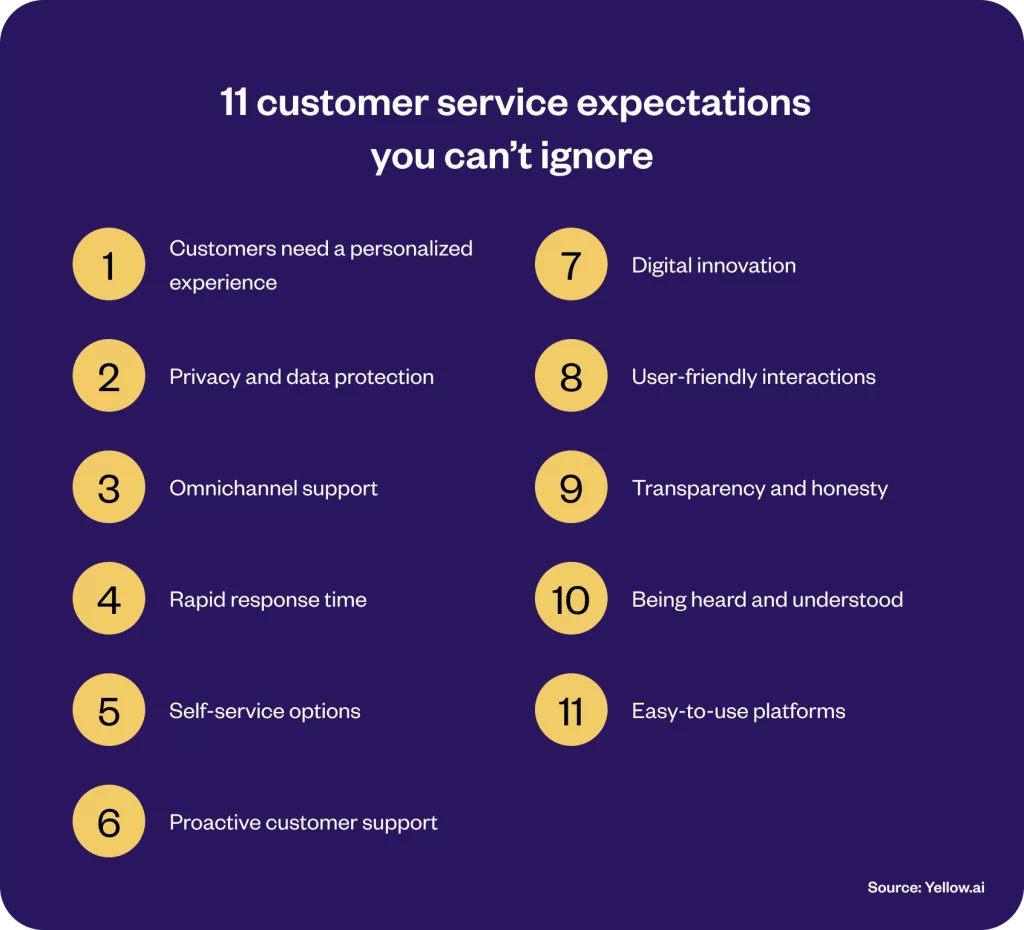
1. Personalized experience
Customers no longer accept one-size-fits-all support. They expect you to use context, like purchase history or prior interactions, to tailor responses.
How to meet it:
- Address customers by name and reference relevant details.
- Use data responsibly to anticipate needs.
- Avoid stereotypes; ask clarifying questions instead..
2. Privacy and data protection
Data handling is a major part of customer service expectations. Customers expect their personal information to be secure and used only with consent.
How to meet it:
- Collect only what’s necessary and explain why.
- Update systems regularly to align with security standards.
- Offer customers control over access or deletion of their data.
3. Omnichannel support
Customers want to engage through the channel of their choice, chat, phone, email, social media, and get consistent answers.
How to meet it:
- Integrate systems so context follows across channels.
- Train teams to deliver the same level of service everywhere.
- Avoid making customers repeat their story.
4. Rapid response time
Speed remains one of the most visible service expectations. Whether on chat, social, or voice, customers value quick acknowledgement and resolution.
How to meet it:
- Set clear response benchmarks by channel.
- Equip teams with knowledge bases for faster replies.
- Balance speed with accuracy, fast but wrong responses frustrate more.
5. Self-service options
Many customers prefer solving problems themselves before contacting support. They expect working self-service tools like FAQs, help centers, or chatbots.
How to meet it:
- Maintain a searchable, up-to-date knowledge base.
- Design self-service flows that are intuitive.
- Always offer a clear path to human help.
6. Proactive customer support
Customer Support shouldn’t only react to issues. Customer satisfaction and customer expectations depend on receiving value timely updates and alerts before they need to ask.
How to meet it:
- Notify customers of delays, outages, or order updates.
- Use data to predict recurring problems and address them early.
- Keep communication relevant, not overwhelming.
7. Digital innovation
Customer service expectations now include technology that makes interactions smoother, AI chatbots, mobile apps, or automated status updates.
How to meet it:
- Use automation to handle simple queries.
- Personalize digital tools so they feel helpful, not generic.
- Ensure new tech adds convenience without removing human options.
8. User-friendly interactions
Customer expectations also include processes that are clear and easy to follow. Every unnecessary step increases the chance of abandonment.
How to meet it:
- Keep forms and flows simple, especially on mobile.
- Provide clear instructions and visible calls to action.
- Continuously test for usability issues.
9. Transparency and honesty
Customers expect brands to communicate clearly about delays, limitations, or mistakes. Overpromising or hiding information breaks trust.
How to meet it:
- Be upfront about timelines and possible issues.
- Take responsibility when errors occur.
- Share updates until the issue is resolved.
10. Being heard and understood
Customers want their concerns acknowledged, not just logged. Feeling dismissed is one of the fastest paths to churn.
How to meet it:
- Train teams to show empathy as well as efficiency.
- Listen actively and confirm understanding.
- Reflect back key concerns before offering solutions.
How to exceed customer expectations
Meeting customer service expectations keeps you competitive. Exceeding them is what creates customer loyalty, advocacy, and long-term growth. Here are the most effective ways enterprises can go beyond the basics:
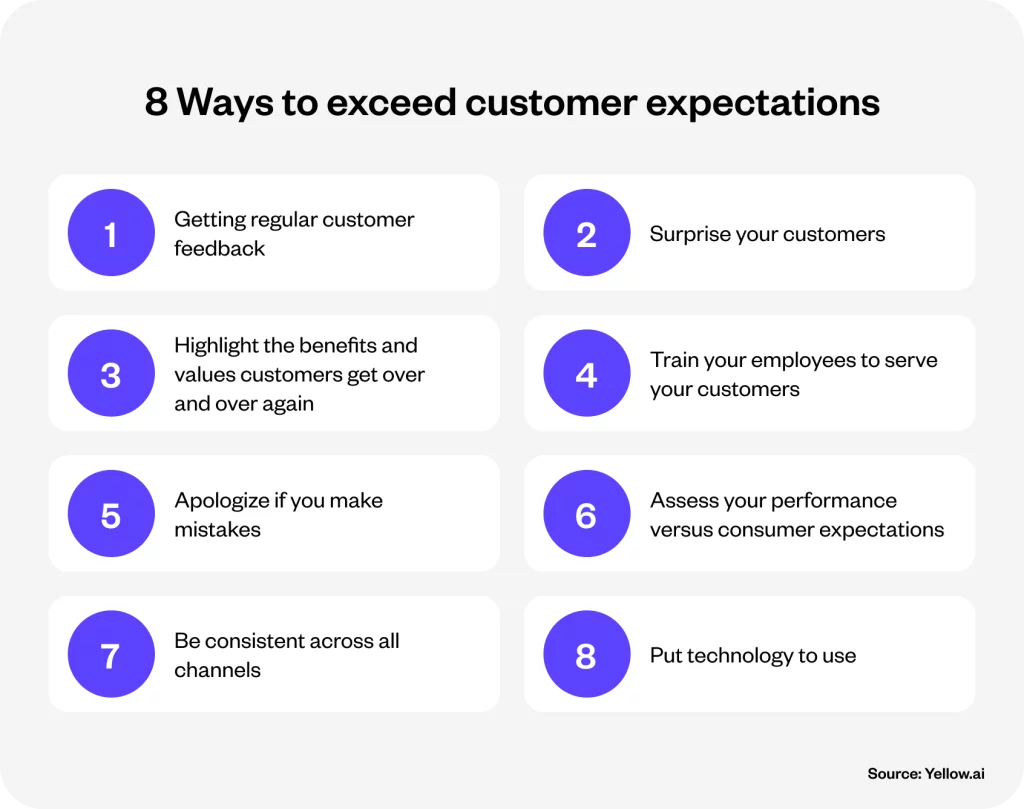
1. Collect feedback continuously
Customer expectations shift quickly as new technologies or competitors raise the bar. Relying only on annual surveys means you’ll miss the signals. Customers expect companies to adapt in real time.
- Use short post-interaction surveys to capture fresh sentiment.
- Track themes in feedback to find recurring friction points.
- Share learnings across departments so improvements happen at scale.
2. Act quickly when mistakes happen
Customer service failures are inevitable, but how they’re handled defines the customer experience. Customers expect acknowledgment, a clear fix, and reassurance that the issue won’t repeat.
- Apologize promptly without shifting blame.
- Communicate next steps with realistic timelines.
- Follow up after resolution to confirm satisfaction.
3. Reinforce value at every touchpoint
Customers don’t just want problems solved; they want to feel the interaction added value. Exceeding customer expectations means showing them how your service reduces effort, saves time, or creates confidence.
- Replace generic “resolved” messages with specific outcomes (For example, “Your refund is processed and will reflect in 3–5 days”).
- Share helpful resources relevant to their issue.
- Remind them of proactive services they may not know about.
4. Equip teams with the right training
Even the best tools won’t close gaps if frontline teams lack context or skills. Customers expect support agents to be knowledgeable and able to take ownership.
- Train on both product details and customer empathy.
- Give agents access to unified knowledge bases.
- Empower them to make small decisions that resolve issues on the spot.
5. Deliver consistency across channels
Customers expect effortless movement between chat, email, phone, and social support. Gaps here cause frustration more than the issue itself.
- Integrate systems so context moves with the customer.
- Audit for message consistency across all support scripts.
- Ensure response time targets are aligned across channels.
6. Use technology to scale quality
Exceeding customer expectations at scale requires automation. Customers expect self-service, faster resolution, and proactive updates without losing the human agents option.
- Automate repetitive requests with chatbots and workflows.
- Use AI-driven analytics to predict and prevent recurring problems.
- Combine automation with agent assist tools to improve first-contact resolution.
Yellow.ai Email Automation, powered by YellowG, its proprietary LLM, can understand unstructured emails, precisely recognize numerous intents, infer the email’s object and urgency, and provide 24/7 response. It identifies the user and provides a relevant response based on user insights, reducing ticket volumes by 80% and improving first-contact resolution by 20%.”
-Raghu Ravinutala, CEO & Co-Founder, Yellow.ai.
Watch this video to learn more about Yellow.ai Email automation!
Put technology to use
Exceeding customer expectations is easier with the right tools. Automate common customer support requests with chatbots and knowledge bases, use analytics to personalize responses, and unify inbound queries across channels with a single platform. This reduces friction, speeds up response times, and ensures consistency regardless of how a customer chooses to connect.
How does Yellow.ai support customer service automation?
Automation plays a central role in meeting rising customer service expectations. According to an Economic Times report, Yellow.ai deployed 120 GenAI for organizations globally this fiscal year, and over 30% of those bots were deployed in India. GenAI mainly automates customer service to cut costs in regions like the US. Many of the expectations outlined earlier, faster replies, consistent answers, working self-service, and proactive updates, can only be delivered at scale with the help of technology. Yellow.ai provides tools that enable this without replacing the human element.
- Handling repetitive tasks
Common queries such as password resets, order status checks, or basic troubleshooting can be automated. This reduces ticket backlogs and allows service teams to focus on more complex issues. - Consistent experiences across channels
With one shared workspace for chat, email, voice, and social channels, customers receive the same information no matter how they choose to engage. - Serving a global audience
Built-in multilingual capabilities mean customers can get support in their preferred language, a critical part of meeting implicit and explicit service expectations. - Always-on availability
Automated chat and voice agents can provide 24/7 coverage and escalate seamlessly when human input is required, ensuring customers aren’t left waiting. - Learning from interactions
Analytics within the platform surface patterns in customer queries and expectations. This helps leaders identify service gaps and make data-driven improvements.
Customer service automation in this sense is not about replacing people but ensuring teams have the capacity to meet expectations consistently. It gives customers faster resolutions while enabling service leaders to focus on building stronger, more reliable experiences.
Ready to lead in customer service in Indonesia with Komodo-7B?
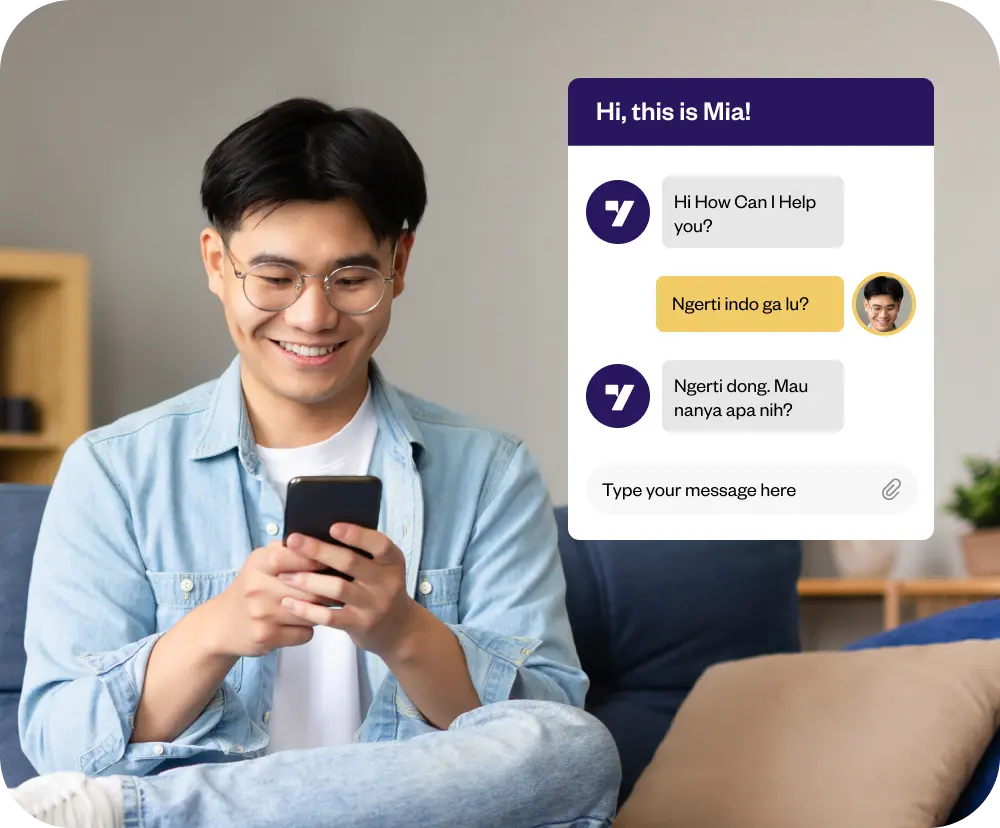
Customer expectations – Key takeaways
Meeting and exceeding customers’ expectations is essential if you want their contentment. You gain their confidence when you consistently satisfy their expectations. Even as consumer expectations rise, staying ahead of their needs may help you personalize your offerings and provide a better experience overall. Customer feedback software, constant product improvement, and open communication help build long-term customer connections. Listening to your consumers allows you to exceed their expectations, position yourself as an industry leader, expand, and build a reputation for excellence. Expectations from customers, already high, will only go up in the years to come. If you keep cognizant of these expectations, you can fulfill them and provide outstanding customer service that adds value. You may improve your ability to satisfy your customers’ expectations by applying the recommendations in this blog. This will encourage your pleased customers to return for future purchases and grow customer loyalty.
Automating customer support effectively

Frequently asked questions (FAQs)
What are the main customer service expectations?
The main customer service expectations are fast response times, consistent answers across channels, reliable self-service, empathy in communication, and easy escalation to a human. These form the baseline standards customers now expect from every company.
What happens if customer service expectations are not met?
If customer service expectations are not met, customers lose trust and often switch providers. Research shows that even two or three poor experiences are enough to drive most customers to competitors, regardless of product quality.
How can businesses measure if they are meeting expectations?
Businesses measure service expectations with metrics like first-reply time, first-contact resolution, total resolution time, CSAT scores, and reopen rates. Tracking these by channel highlights gaps and guides improvements.
Why is personalization important in customer service?
Personalization is important because it makes customers feel recognized and valued. Using context from past purchases or prior interactions creates more relevant answers, reduces frustration, and strengthens loyalty.
How does technology help companies meet expectations?
Technology helps companies meet customer service expectations by automating routine requests, providing 24/7 coverage with AI chatbots, and ensuring consistent information across channels. This allows human agents to focus on complex cases while maintaining speed and accuracy at scale.
What is a good benchmark for response time in customer service?
A good benchmark for response time is under 12 hours for email, under 1 hour for social media, less than 2 minutes for phone support, and under 1 minute for live chat. These targets reflect current customer service expectations and are often used to measure support performance.
